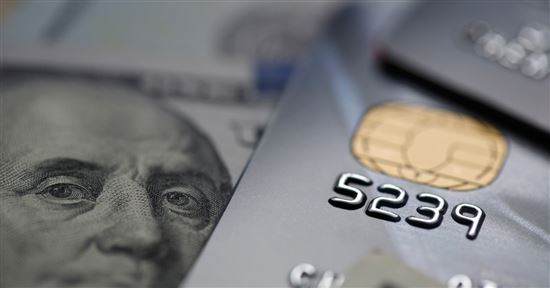Shocking Facts about Average Credit Card Debt
The average credit card debt in America is $6,028 per person. We dive deeper into the facts behind this number. Read on to see how you compare.
We love our credit cards in America. But unfortunately, credit card debt is a major problem.
Facts and Figures at a Glance
- The average credit card debt is $6,028.
- 55% of credit card users don't always pay in full.
- 83% of adults have at least one credit card.
- The average number of credit cards per person is 3.1.
- The current outstanding revolving debt in the U.S. is $1.089 trillion.
- The average APR on credit card accounts assessed interest is 21.25%.
- Baby Boomers and Generation X have the most debt.
Credit cards have simplified our lives and helped us reach personal goals. But their overuse has also contributed to an ever-growing debt problem.
Read on for the shocking facts you need to know.
 |
Being able to open multiple credit cards easily and have credit at your fingertips means that many Americans can spend more, but it also means that not paying off bills in full each month means that debts start to build up.
About 77% of American households have debt of some kind. And the average credit card debt is $6,028.
Credit Card Debt in the United States
Credit card debt is revolving debt, which means that it's an open-ended line of credit. You can keep borrowing up to the amount of your credit limit as long as you keep paying your bill.
Revolving debt can be very easily abused because you can carry a balance from month to month, and you just need to pay the minimum to keep going. This makes it easy for people to buy things they can't actually afford.
The latest Consumer Credit release from the Federal Reserve (October 2019) showed that credit card debt has reached a record high. The current total consumer debt in the U.S. is $4.165 trillion, with outstanding revolving debt being $1.089 trillion. This is a $201 billion increase from 2014, just 5 years ago.
| Year | Outstanding Revolving Debt (in billions) |
|---|---|
| 2013 | 888.0 |
| 2014 | 906.7 |
| 2015 | 968.0 |
| 2016 | 1,022.1 |
| 2017 | 1,053.5 |
| 2018 | 1,088.7 |
U.S. Credit Card Usage
Credit card usage can be broken down into three main types:
- Transactors (30.4%): They use cards for convenience and pay off their balance in full each month. They are not in any debt and owe no interest.
- Revolvers (43.8%): They carry a credit card balance from month to month and thus accumulate interest and debt over time.
- Dormants (25.8%): They have a credit card, but don't actively use it.
According to the Federal Reserve's 2018 report on the economic well-being of U.S. households, 47% pay off their balance in full in each month. Out of the cardholders who don't always pay in full, about half always carry a balance.
| Always pay in full each month | 47% |
| Carry a balance most of the time | 27% |
| Carry a balance some of the time | 21% |
| Carried a balance once in the past year | 5% |
Things are looking up somewhat, though. In recent years, the average credit card debt has dropped by 3%. The Federal Reserve Bureau's Report on Changes in Family Finances from 2013 - 2016 shows that the average credit card debt has dropped from $5,900 to $5,700. Our estimates show that the average debt is even lower by the end of 2016, at $5,331.
While the average plastic debt for families has dropped, the percentage of families with debt have actually increased. 43.9% of families in 2016 have credit card debt (as opposed to 38.1% in 2013). This suggests that more people are having trouble paying off their balance, but are keeping their debt levels lower.
Credit Card Debt by Generation
Data from a 2017 study shows that Generation X and Baby Boomers have the highest credit card debt at an average of $7,750 and $7,550 per person.
It's not surprising when you consider that Baby Boomers are largely responsible for the growth of the U.S. economy and consumerist culture. They also average the highest number of credit cards at 3.5 cards per person.
However, the younger generations (X, Y, and Z) have the highest amount of revolving credit card usage. 36-37% keep a balance on their card, as opposed to 29% of the Baby Boomers and only 16% for the Silent Generation (the oldest generation).
| Generation | Age | Debt |
|---|---|---|
| Silent Generation (Traditionalists) | age 72+ | $4,613 |
| Baby Boomers | age 54-72 | $7,550 |
| Generation X | age 38-53 | $7,750 |
| Generation Y (Millennials) | age 24-38 | $4,315 |
| Generation Z (iGeneration) | age 23 & under | $2,047 |
Credit Card Debt by Race
Per the Shift Processing's latest in-depth data on debt, those who identified themselves as white carried the highest amount of credit card debt at $6,500. Blacks and Hispanics carried the least amount at $3,800.
Here's how the races stack up from the highest debt to lowest:
| Race | Debt | % with Debt |
|---|---|---|
| White | $6,500 | 42.1% |
| Black | $3,800 | 47.8% |
| Hispanic | $3,800 | 49.6% |
| Other | $5,700 | 44.1% |
Best and Worst States for Credit Card Debt
Based on Experian's 2017 State of Credit, here are the top 5 and bottom 5 average credit card debt by state:
Top 5:
- Alaska: $8,515
- Connecticut: $7,258
- Virginia: $7,161
- New Jersey: $7,151
- Maryland: $7,043
Bottom 5:
- West Virginia: $5,547
- North Dakota: $5,511
- Mississippi: $5,421
- Wisconsin: $5,363
- Iowa: $5,155
Credit Card Debt by Income
The same study also showed that making more money doesn't mean less debt. The opposite is true, actually. Households with higher income also carry a higher credit card balance. This is most likely because high earners have more spending power and access to higher credit limits.
The Federal Reserve found that just 29% of households in the lowest quintile have credit card debt compared with over 50% of households with income in the 40-90% percentile. And 34% of those in the highest income bracket (90-100% percentile) carry debt.
However, note that the percentage of debt as income increases is lower. For those with income in the lowest quintile, their debt is 15% of their annual income. For the highest earners, their debt is only 2.4%.
| Percentile of income | Average income | Average Debt | % with Debt |
|---|---|---|---|
| Lowest 20 | $14,400 | $2,100 | 29.0% |
| 20 - 39.9 | $31,800 | $3,800 | 41.7% |
| 40 - 59.9 | $53,400 | $4,400 | 53.0% |
| 60 - 79.9 | $87,400 | $6,800 | 52.8% |
| 80 - 80.9 | $138,700 | $7,800 | 51.5% |
| 90 - 100 | $514,700 | $12,500 | 34.4% |
Credit Card Debt by Household Net Worth
The more net worth a household has, the more debt they carry. Even though only 20% of those in the highest net worth percentile has credit card debt, they carry the most.
| Percentile of Net Worth | Debt | % with Debt |
|---|---|---|
| Lowest 25th | $4,000 | 40.0% |
| 25 - 49.9 | $5,000 | 52.1% |
| 50 - 74.9 | $6,200 | 53.1% |
| 75 - 89.9 | $7,400 | 37.5% |
| 90 - 100 | $11,200 | 19.8% |
Credit Card Debt by Employment
The same Federal Reserve report found that households where the head is self-employed carry the highest credit card debt, while retired folks have the least. While over 50% of employed people have debt, and only 29% of those not working have debt, they carry about the same amount.
| Job Status | Average Debt | % with Debt |
|---|---|---|
| Employed | $5,700 | 50.4% |
| Self Employed | $8,000 | 46.1% |
| Retired | $4,600 | 32.7% |
| Not working | $5,600 | 28.9% |
Credit Card Debt by Education
Interestingly, the same study showed a direct correlation between debt and education level. The higher the education level, the more likely the person is to have higher credit card debt. Again, this could be because those with a higher education earn more income and thus have greater spending power.
Those with college degrees have an average of $8,200 in debt while those who did not graduate high school have an average of just $3,800.
| Degree | Average Debt | % with Debt |
|---|---|---|
| No high school diploma | $3,800 | 35.2% |
| High school graduate only | $4,600 | 44.3% |
| Some college, no degree | $4,700 | 50.8% |
| College Degree | $8,200 | 41.3% |
Main Causes of Credit Card Debt
In a study done by Demos, it was found that the main causes of credit card debt in working age, low- and middle-income households include:
- Home value: Homeowners that have negative equity in their homes are 24% more likely to have credit card debt.
- Insurance coverage: Households are 20% more likely to carry credit card debt when a member has gone without health insurance at some point in the past 3 years.
- Children: Households with children under age 18 are 15% more likely to have credit card debt than those without kids.
- Unemployment: Households are 14% more likely to have credit card debt when someone has been unemployed for at least 2 months in the past 3 years.
So What Can You Do About Your Credit Card Debt?
 |
| © CreditDonkey |
If you have some credit card debt, it's never too late to get a handle on it. Here are some steps you can take:
- Do a balance transfer. A balance transfer is one of the smartest moves. This is when you move your debt onto a new card with an intro 0% APR for balance transfers. This gives you time to pay off debt without accumulating more interest.
For example, if you find a balance transfer promotion with a 15-month intro APR, that's 15 whole months you can focus on paying off debt with no additional interest.
Here's a list of our top cards with intro 0% APR balance transfer offers.
- Pay more than the minimum. Make more than just the minimum payment whenever you're able. Even throwing in a few extra dollars a month can make a difference in a long run.
Play around with our credit card payoff calculator to see how different payments amounts will affect the total number.
Consider this scenario: If you have $5,000 in debt with a 13.5% interest rate, a payment of $100/ month will take you 74 months to pay off. You'll end up paying $2,390 in interest alone--that's half of the debt.But if you put just $50 more a month toward the payment, it'll reduce the payoff time to 43 months. That will shave off $1,088 in interest.
- Create a budget. The most important is to stick to a budget. You must set aside funds every month for paying off debt.
This will mean having to cut out unnecessary spending. And it will take discipline. For example, avoid shopping malls when you need a pick-me-up. Cook more instead of eating out.
Just remember that every dollar you're saving will be putting you on the path to being debt free.
For more ways, check out our detailed guide to pay off credit card debt fast.
Common Questions
How long does it take to get out of credit card debt?
To calculate how long it'll take to pay off your credit card debt, use our payoff calculator.
You can enter in different payment amounts and see how long it will take you to clear the debt. You'd be surprised that just paying a little bit more each month can drastically reduce the payoff time.
What happens to debt when you die?
In the event of death, your estate will pay off any outstanding debt. Your estate is all the assets you own (bank accounts, house, cars, etc.). After your debt is paid off, your heirs will receive any remaining assets.
If your estate is not enough to cover your debt, then the lenders will just take a loss.
How much is a lot of credit card debt?
This answer is different for everyone, as it depends on how much you can take on and still stay afloat. But the general rule is to keep your credit utilization below 30%. If it goes over 30%, this is when it starts to affect your credit.
For example, if your total credit limit between all your cards is $15,000, your debt should be kept below $4,500.
What is the average credit card limit?
Based on ABA's October 2018 report, the average credit card line is approximately $8,860. It's broken up as follows:
- $11,656 for super prime accounts
- $7,448 for prime accounts
- $3,693 for sub prime accounts
Bottom Line
Although consumer credit card debt has decreased in recent years, it's still a major problem for a lot of Americans. But don't feel too discouraged because, as you can see from this article, you're not alone.
The road to paying off credit card debt starts with facing reality. You need a solid plan and a lot of self-discipline to use a credit card responsibly. Staring at those numbers can be intimidating, but you're capable of getting out of debt as long as you're committed.
To break it down for you in clear, actionable steps, check out our beginner's guide to paying off debt fast. You'll find digestible steps that are easy to follow. It's never too late to get on the road to financial freedom.
Sources and Additional References
Write to Anna G at feedback@creditdonkey.com. Follow us on Twitter and Facebook for our latest posts.
Read Next:

